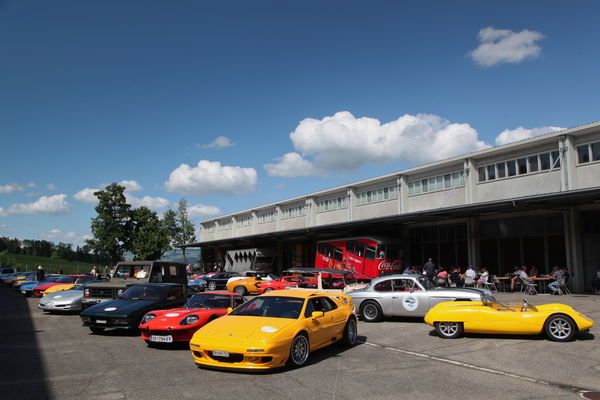The Fantastic Plastic car meeting took place for the 6th time on June 2, 2018. Dedicated to cars with plastic bodies instead of sheet steel or aluminum, a rather extensive selection of unusual cars had once again registered, around 100 vehicles in total.

In the center
The event began at the entrance to the Lucerne Museum of Transport, where the cars were lined up on the large piazza in front of the car hall. Around midday, the crowds made their way to the new Mall of Switzerland, where the colorful sports cars and leisure cars not only provided variety, but also significantly increased the number of visitors to the shopping center.

Then it was over the Michaelskreuz and through beautiful countryside to Rain, where the day ended in the best weather conditions in the outdoor storage area of the Verkehrshaus. Of course, the sausage was just as much a part of it as the guided tour through the reserves of the Lucerne museum, which are not normally open to the public.

Brand diversity
Once again, the non-branded meeting shone with great diversity. Of course, the well-known plastic car manufacturers Lotus and Chevrolet (Corvette) were represented, but there were also many small suppliers that some people have probably long forgotten.
Founder of Tornado repeats his honeymoon
For his 60th wedding anniversary, Bill Woodhouse restored his first Tornado Typhoon together with friends. Woodhouse founded this sports car brand in the 1950s and built a number of very interesting vehicles, two of which were on display in Lucerne.

Woodhouse was joined by other Brits at the Lucerne meeting, and together they certainly presented the most unusual and rarest small-series vehicles.
Franco Sbarro's Mille Miglia
The designs by Franco Sbarro, who likes to work with plastic, are also really rare. He presented the Mille Miglia at the Geneva Motor Show in 2005, when the technology was already around two decades old, having originated from the Ferrari 365 GT4 2+2.
An elegant but relatively massive barchetta body arches above it. At least three of these cars are said to have been built at the time, one of which found its way to Lucerne on June 2, 2018 and was much admired.
Monteverdi's Saurer
Also extremely rare is an off-road vehicle called the Saurer 232 M. Its roots go back to Peter Monterverdi, who wanted to sell the 4x4 utility vehicle to the army as a successor to the Jeep. Saurer was supposed to take over production, but the army opted for the Puch G, resulting in just under two dozen prototypes, almost all of which are now in private hands.
One of these off-road vehicles with a plastic body could be admired in Lucerne and thus almost embodied the antipode to all the flat sports cars on the square.
Ever heard of a De La Chapelle?
France has always produced interesting sports cars, such as the mid-engined cars from Matra, some of which were on display in Lucerne, or the MVS Venturi. The De La Chapelle Roadster, a compact mid-engined sports car with four or six-cylinder engines and pleasing proportions, also comes from the same "kitchen".
The production of this car, which was introduced in the mid-1990s, is of homeopathic dimensions, which makes it all the more interesting to be able to admire one of these rare cars at a meeting.
Leisure cars of different colors
In the sixties and seventies, buggies were produced in much larger numbers. Back then, people usually bought an obsolete VW chassis and a kit with a plastic tub and accessories and spent a few weekends building their own individual buggy.
Creative color schemes and the widest possible rear tires were just as much a part of it as ingeniously shaped exhaust pipes and hot-looking bucket seats. Buggy kits were available from various manufacturers, some of whom even developed them in Switzerland. Some of the range of buggy variants available at the time could also be seen in Lucerne.
For those who found this too rustic, the French alternative based on the Citroën Diane, the Méhari, was perhaps more appealing.
From two to twelve cylinders
The two extremes have already been mentioned, but there were also some vehicles with eight cylinders, such as the TVR Cerbera from Blackpool or the Lotus Esprit. The Cobra and the Daytona replica also got down to business with V8 power. Not everyone wants to come up with beautiful shapes themselves, especially as there are plenty of successful role models.
Replicas are as much a part of the plastic scene as buggies or individual creations. Two MP Lafer, based on the MG TD, represented this plastic car segment, among others.
Guest of honor Alpine
Alpine and Alpine-Renault were represented with a dozen and a half cars. The "Berlinette" was represented several times and there were also the 1600 and V6 versions of the A310 to admire. Even a late A610 had found its way to Lucerne.

Founded in the 1950s by Jean Rédélé, a gifted rally driver and tinkerer, the Alpine brand made a name for itself primarily through its many rally victories, including at the Monte Carlo Rally. But an Alpine also won the 24 Hours of Le Mans. The brand was taken over by Renault in the 1970s and sports cars were produced under the brand for the last time in the mid-1990s.
Until 2017, when the new A110 was presented in Geneva.
The current Alpine A110 was shown as the icing on the cake, so to speak. Although its body has hardly any more plastic, the new A110 is certainly a credible successor to the Berlinette in terms of looks and driving dynamics. In fact, it is so popular that the first series is already sold out. Anyone ordering a variant of the second series now will get it in spring 2019 at the earliest. The new Alpine therefore definitely has what it takes to become a niche bestseller, as the admiring glances that fell on the Alpine showed.











































































































































































